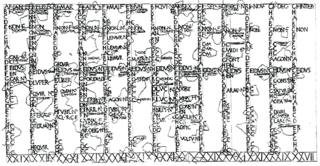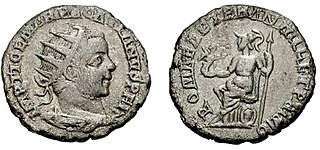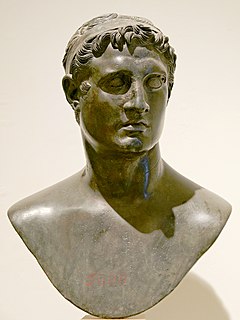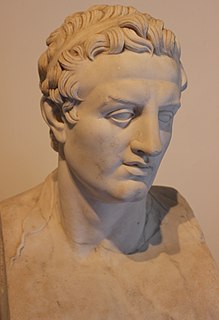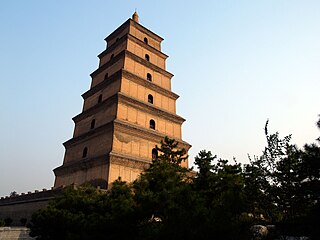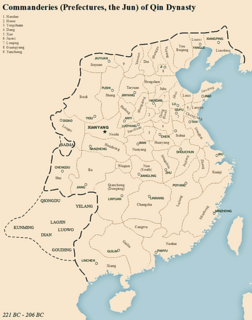
The Seleucid Empire was a Hellenistic state ruled by the Seleucid dynasty which existed from 312 BC to 63 BC; Seleucus I Nicator founded it following the division of the Macedonian Empire vastly expanded by Alexander the Great. Seleucus received Babylonia and from there expanded his dominions to include much of Alexander's near-eastern territories. At the height of its power, the Empire included central Anatolia, Persia, the Levant, Mesopotamia, and what is now Kuwait, Afghanistan, and parts of Pakistan and Turkmenistan.
This article concerns the period 229 BC – 220 BC.
This article concerns the period 249 BC – 240 BC.

Seleucus II Callinicus Pogon, was a ruler of the Hellenistic Seleucid Empire, who reigned from 246 BC to 225 BC. Faced with multiple enemies on various fronts, and not always successful militarily, his reign was a time of great turmoil and fragmentation for the Seleucid empire, before its eventual restoration under his second son and eventual successor, Antiochus III.
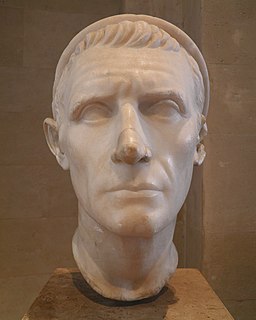
Antiochus III the Great was a Hellenistic Greek king and the 6th ruler of the Seleucid Empire. He ruled over the region of Syria and large parts of the rest of western Asia towards the end of the 3rd century BC. Rising to the throne at the age of eighteen in 222 BC, his early campaigns against the Ptolemaic Kingdom were unsuccessful, but in the following years Antiochus gained several military victories and substantially expanded the empire's territory. His traditional designation, the Great, reflects an epithet he assumed. He also assumed the title Basileus Megas, the traditional title of the Persian kings. A militarily active ruler, Antiochus restored much of the territory of the Seleucid Empire, before suffering a serious setback, towards the end of his reign, in his war against Rome.

Diodotus I Soter was Seleucid satrap of Bactria, rebelled against Seleucid rule soon after the death of Antiochus II in c. 255 or 246 BC, and wrested independence for his territory, the Greco-Bactrian Kingdom. He died in 239 BC.

Antiochus VIII Epiphanes/Callinicus/Philometor, nicknamed Grypus, was the ruler of the Syrian Seleucid Empire from 125 to 96 BC. He was the younger son of Demetrius II and Cleopatra Thea. He may have spent his early life in Athens and returned to Syria after the deaths of his father and brother Seleucus V. At first he was joint ruler with his mother. Fearing her influence, Antiochus VIII had Cleopatra Thea poisoned in 121 BC.
Cleopatra VI Tryphaena was an Egyptian Ptolemaic queen. She may be identical with Cleopatra V.
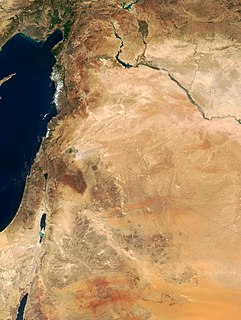
The Syrian Wars were a series of six wars between the Seleucid Empire and the Ptolemaic Kingdom of Egypt, successor states to Alexander the Great's empire, during the 3rd and 2nd centuries BC over the region then called Coele-Syria, one of the few avenues into Egypt. These conflicts drained the material and manpower of both parties and led to their eventual destruction and conquest by Rome and Parthia. They are briefly mentioned in the biblical Books of the Maccabees.
Laodice VII Thea Philadelphus, was a Greek–Syrian princess of the Seleucid Empire and future queen of Commagene. She was the daughter of Greek–Syrian King Antiochus VIII Grypus and Greek Ptolemaic Princess Cleopatra Tryphaena, a daughter of Ptolemy VIII Physcon.
Laodice was a Greek Princess of the Seleucid Empire. She was one of the daughters and youngest child born to the Seleucid Monarchs Antiochus II Theos and Laodice I. Among her siblings were her brothers Seleucus II Callinicus and Antiochus Hierax. Laodice was born and raised in the Seleucid Empire.
Tryphaena was a Ptolemaic princess. She married the Seleucid king Antiochus VIII Grypus and was queen of Syria.
Epigonos of Telmessos, also known as Epigonos was a Greek Prince from Asia Minor.
Ptolemy II of Telmessos who is also known as Ptolemy II. He is identified as Ptolemy of Telmessos and Ptolemy son of Lysimachus. Ptolemy II was a Greek Prince from Asia Minor who served as a Ptolemaic Client King under the Ptolemaic dynasty of Ancient Egypt.
Berenice also known as Berenike, was a Greek Princess from Asia Minor who was a distant relative of the Seleucid Monarch Antiochus III the Great.
The Battle of Ancyra was fought in ca. 237 BC between the Seleucid King Seleucus II Callinicus and his brother Prince Antiochus Hierax. Civil war had raged in the Seleucid Empire since 244 BC, when Queen Laodice I had supported her son Antiochus in a rebellion against Seleucus. Antiochus fought to establish his own kingdom in Anatolia. He was able to take advantage of his brother's distraction and defeat at the hands of Ptolemy III in the Third Syrian War. By 239 BC Seleucus had made peace with Ptolemy and having rebuilt his army, invaded Anatolia.
